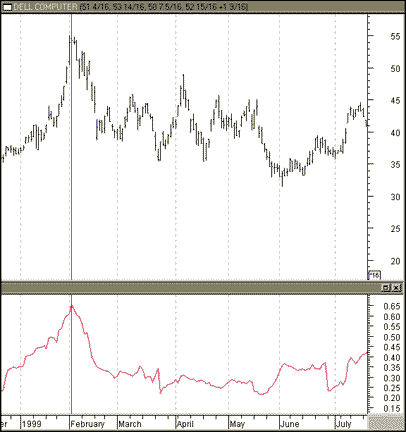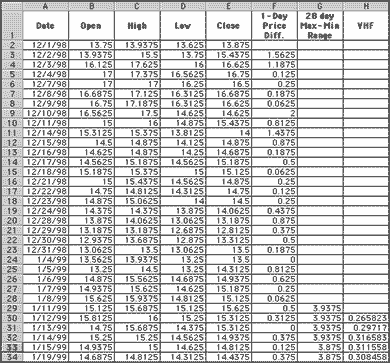Vertical Horizontal Filter
by Jayanthi Gopalakrishnan
This filter can tell you whether a market is going through a trending or congestion phase, and whether you should use trend-following indicators if the markets are trending or congestion-phase indicators if markets are in a trading range.
It's always a challenge to determine which indicator you should use to help you make your trading decisions. Markets go through various stages such as trending or congestion phases, and you cannot use the same indicators for all the different phases. As a result, you must identify the different phases of the markets before you can apply the indicator appropriate for that stage.

FIGURE 1: TRENDING AND CONGESTION PHASES. The VHF indicator identifies when a market is going through a trending or congestion phase.
The vertical horizontal filter (VHF), which was introduced by Adam White in 1991, is one indicator you can use to determine whether a security is going through a congestion phase or a trending phase. The VHF is not your typical indicator that gives you buy and sell signals; what the VHF does is help you decide which indicators to apply. During a trending phase, the vertical rise in prices is stronger than during a congestion phase. The VHF measures the vertical rise in prices over time.
The calculation of the VHF indicator is relatively simple, and it is explained in the sidebar, "The vertical horizontal filter."
IN THEORY
The VHF indicator can be used:
1 To determine whether a specific market is trending or in a congestion phase. A rising VHF line indicates the trend is strong, whereas a falling line indicates it is weak.
2 To determine the strength of a trend. A VHF reading above a certain benchmark may indicate a strong trend, whereas a reading below another benchmark indicates it is weakening.
3 As a contrarian indicator. If you see relatively low VHF values, you can expect prices to break out of the congestion phase and start trending. Conversely, a relatively high VHF value indicates that the trending phase may have come to an end and the market will be entering a congestion phase.
When the VHF indicator is relatively flat, it indicates that the market is in a congestion phase. When it starts rising above the range it was in while in the congestion phase, it indicates the market is trending. Generally, securities spend more time in a congestion phase than in a trending phase. In Figure 1, you can see the different phases of the market as indicated by the VHF. Note there is only one period where the VHF indicates the market is going through a trend. The section marked "A" identifies a trending period, whereas the one marked "B" identifies a congestion phase. Note the action of the VHF line. During a trending period, it rose significantly higher than during the congestion phase. It went lower when the trend started declining and entered a congestion phase.
The VHF indicator only reveals the strength of a trend; it does not indicate trend direction. Just as the VHF increased during an upward trending period, as can be seen in Figure 1, the same can be seen for a downward trend. Take a look at Figure 2 and note how, during a downward trend (sections A and B), the value of the VHF indicator rises sharply, indicating the downward trend is strong.
THE VERTICAL HORIZONTAL FILTER
The vertical horizontal filter (VHF) is an indicator that can help determine whether a market is trending. The formula for the 28-day VHF is:
where the numerator is the difference between the highest close and the lowest close for the last 28 days and the denominator is the 28-day sum of the absolute value of the one-day price change.
SIDEBAR FIGURE 1: EXCEL SPREADSHEET. This Excel spreadsheet calculates the vertical horizontal filter.
As shown in sidebar Figure 1, the first step is calculating the absolute value of the one-day price change. This is performed in column F. The formula for cell F3 is:=(ABS((E2-E3)))
Next, the highest close minus the lowest close for the last 28 days is calculated in column G. The formula for cell G29 is:
=(MAX(E2:E29)-MIN(E2:E29))
The Vhf indicator is calculated in column H. The formula for cell H30 is:
=G30/(SUM(F3:F30))
-- Tushar Chande
Jayanthi Gopalakrishnan is a Staff Writer for STOCKS & COMMODITIES.
Excerpted from an article originally published in the July 2000 issue of Technical Analysis of STOCKS & COMMODITIES magazine. All rights reserved. © Copyright 2000, Technical Analysis, Inc.
Return to July 2000 Contents

